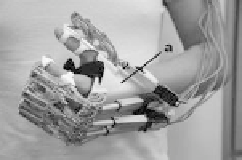Biomedical Engineering Reference
In-Depth Information
Figure 6.1
The task training hand system (a) actuators platform (b) linear actuator and (c)
finger assembly. For color reference, see page 215.
6.2.1 Task Training Wearable Hand System
The first design is the task training wearable hand systemwhich assists the user to
practise the hand opening and palmar grasp functions with task oriented training
(in
Figure 6.1
). It consists of a platform with five finger assemblies (one for each
finger) and each finger assembly is actuated by one linear actuator. The linear
actuator can move the metacarpal phalangeal (MCP) joint and interphalangeal
(PIP) joint of the finger at the same time to generate finger extension and flexion.
The range of motion for the MCP joint is 55
◦
and the PIP joint is 65
◦
. By adjusting
the finger assembly to align the virtual centres to the MCP and PIP joint centres,
the design can accommodate different palm size and finger length. It is a portable
design where the total weight is approximately 500 grams. And the user can carry
it around to practise hand function with their daily living activites.
6.2.2 Hand Function Training and Evaluation System
A hand function training and evaluation system is designed for training as well as
evaluating hand functions such as the range of motion, finger forces and muscle
control coordination of hand opening and hand grasp functions (in
Figure 6.2
)
.
Position and force sensors have been integrated with motor system. It consists
of two platforms that house the actuators and the arm. The poles of these two
Figure 6.2
The hand function evaluation system (a) base support platform (b) hand
support platform (c) actuators platform.



















